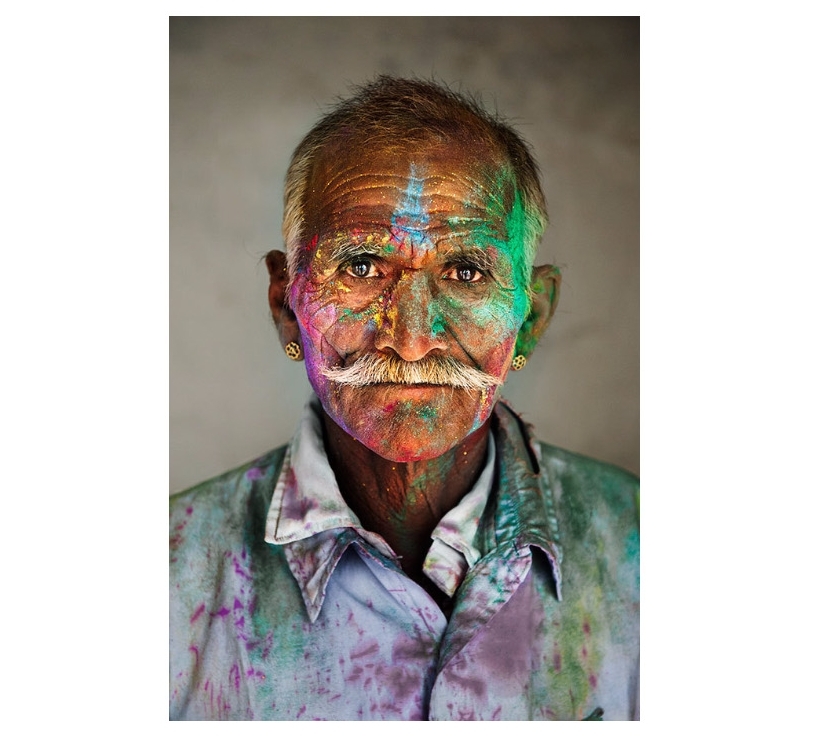
The Hindu festival of Holi is a celebration of the victory of good over evil. The holiday occurs during an agriculturally fruitful time of the year, giving people good reason to revel. Celebrants of all ages and walks of life come together to join in the festivities!
There are many different celebratory activities that take place during this festival. On the night before Holi, people all over India light bonfires, a practice known as Holika Dahan. During the actual day of Holi, people rush to the streets and throw colored powder in the air, and children have fun stirring up trouble and pranking adults and other kids alike. The colored powder tradition, Dhuleti, has become popularized in outside of India and is celebrated on many college campuses around the U.S.

In the Rubin Museum exhibition Steve McCurry: India (closing April 4), several photographs capture moments during vibrant Holi celebrations. In one of McCurry’s photos, entitled “Crowd carries a man during the Holi Festival, Rajasthan,” a group of Northern Indian men covered in red pigment lift a man coated in green. In Holi tradition, the red represents purity, while green symbolizes vitality.
![Crowd carries a man during the Holi Festival, Rajasthan Steve McCurry [origin]; 1996 (Printed: New York; 2015) Archival Pigment Print Display size: 40 x 60 inches Steve McCurry L174.1.14](http://rubinmuseum.org/images/content/main_900.jpg)
Learn about the origins of Holi traditions in these three legends:
Holi Bonfires
According to legend, there was a stubborn and spiteful king, Hiranyakshyap. He let his power get to his head and believed that he was as mighty as the gods. Eventually, he issued a ruling that all of his subjects must pray to him, and to him alone. In defiance of the king, Hiranyakshyap’s son, Prahlad, prayed to Vishnu the King’s greatest enemy. Hiranyakashipu called for his son’s execution, but every attempt failed because Prahlad was protected by Vishnu. Finally, Hiranyakashipu called upon his sister Holika, who had the power to withstand fire. Holika lured Prahlad to enter a fire with her, but the result was not in favor of the king; Holika burned, since her power dictated that she could only survive a fire when she was alone. Her death was a punishment from the gods for trying to kill her nephew. Prahlad, on the other hand, survived because of his devotional prayers to Vishnu. This is the origin of Holika Dahan (translated to Holika’s Death) when Hindus light bonfires the night before Holi.
Dhuleti Celebrations
Krishna is one of the most popular of the Hindu deities. In the Hindu tradition, there is a group of women, also known as the gopika, who are followers and devotees of Krishna. Radha was a prominent gopika and Krishna was very close with her. When he was young, the blue-skinned Krishna was jealous of Radha’s beautiful light complexion and complained to his mother. In response, she told him that he could make Radha any color he wanted if he just smeared pigments on her. From then on, there have been depictions of Krishna, Radha, and the other gopikas dousing each other with colored powder, the origin of the Dhuleti tradition.
Pranks and Jokes
The Ogress Dhundhi was a troublesome creature in the kingdom of Prithu; she would devour young, innocent children, and cause chaos. Ogress Dhundhi was invulnerable to man-made weapons like swords and arrows, but thanks to a curse from Shiva, her Achilles heel was being pranked by little boys! Eventually, the king called on the boys of his kingdom to attack the ogress. She was no match for the pranks and jokes thrown at her by these youths. This legend became the basis for the traditionally high-spirited and boisterous nature of children during the celebration of Holi.
Discover beautiful photos of Holi celebrations and life throughout India in the exhibition, Steve McCurry: India, on view at the Rubin Museum through April 4th.
Add Your Thoughts
Comments are moderated, and will not appear on this site until the Rubin has approved them.

